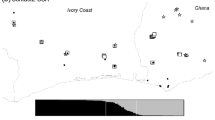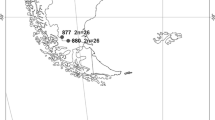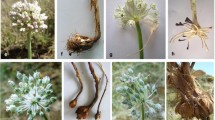Abstract
Recent hybrid speciation events between the diploidCardamine rivularis and the diploidC. amara leading to the triploidC. xinsueta were investigated with random amplified polymorphic DNA (RAPD). The hybrid nature ofC. xinsueta was confirmed by the additivity of RAPD markers which discriminate the parent species. An unexpectedly high level of genetic variation withinC. xinsueta argues for several hybridization events and/or backcrossing withC. rivularis. A low number of nonparental bands inC. xinsueta indicates the younger age of this taxon. In contrast to the situation inC. xinsueta, low variability was observed in the hexaploidC. schulzii, a derivative species ofC. xinsueta: C. schulzii probably originated recently by a single autopolyploidization event. The higher number of non-parental bands inC. schulzii is explained by the changing genetic variability of the parental populations. Evidence for potential gene flow across the ploidy levels is also provided.
Similar content being viewed by others
References
Bachmann K. (1994): Tansley review No. 63—Molecular markers in plant ecology.New Phytol. 126: 403–418.
Brochmann C., Stedje B. &Borgen L. (1992): Gene flow across ploidal levels inDraba (Brassicaceae).Evol. Trends Pl. 6: 125–134.
Crawford D.J., Brauner S., Cosner M.B. &Stuessy T.F. (1993): Use of RAPD markers to document the origin of the intergeneric hybrid ×Margyracaena skottsbergii (Rosaceae) on the Juan Fernandez Islands.Amer. J. Bot. 80: 89–92.
Doyle J.J. &Doyle J.L. (1987): A rapid DNA isolation procedure for small quantities of fresh leaf tissue.Phytochem. Bull. Bot. Soc. Amer. 19: 11–15.
Hadrys H., Balick M. &Schierwater B. (1992): Applications of random amplified polymorphic DNA (RAPD) in molecular ecology.Molec. Ecol. 1: 55–63.
Hedge I.C. (1976): A systematic and geographical survey of the old worldCruciferae. In:Vaughan J.G., MaCleod A.J. &Jones B.M.G. (eds.),The biology and chemistry of the Cruciferae, Acad. Press, London, New York, San Francisco, pp. 1–45.
Lewis W.H. (ed.) (1980).Polyploidy. Biological relevance, Plenum Press, New York.
Lövkvist B. (1956): TheCardamine pratensis complex. Outlines of its cytogenetics and taxonomy.Symb. Bot. Uppsal. 14 (2): 1–131.
Lumaret R. &Barrientos E. (1990): Phylogenetic relationships and gene flow between sympatric diploid and tetraploid plants ofDactylis glomerata (Gramineae).Pl. Syst. Evol. 169: 81–96.
Marhold K. (1993):Cardamine amara L. &C. pratensis. L. In:Tutin T.G. et al. (eds.),Flora Europaea 1, Ed. 2, Cambridge University Press, Cambridge, pp. 349–350.
Mummenhoff K. &Hurka H. (1995): Allopolyploid speciation inArabidopsis (DC.)Heynh.: evidences from chloroplast and nuclear genome markers.Bot. Acta 108: 449–456.
Rieseberg L.H. (1995): The role of hybridization in evolution: old wine in new skins.Amer. J. Bot. 82: 944–953.
Saitou N. &Nei M. (1987): The neighbor-joining method: a new method for reconstructing phylogenetic trees.Mol. Biol. Evol. 4: 406–425.
Sambrook J., Fritsch E.F. &Maniatis T. (1989):Molecular cloning: a laboratory manual 1. Ed. 2. Cold Spring Harbor Laboratory Press, Cold Spring Harbor.
Smith J.F., Burke C.C. &Wagner W.L. (1996): Interspecific hybridization in natural populations ofCyrtandra (Gesneriaceae) on the Hawaiian Islands: evidence from RAPD markers.Pl. Syst. Evol. 200: 61–77.
Soltis D.E. &Soltis P.S. (1993): Molecular data and the dynamic nature of polyploidy.C.R.C. Crit. Rev. Pl. Sci. 12: 243–273.
Swofford D.L. (1990).PAUP: Phylogenetic analysis using parsimony, Version 3.0. Illinois Natl. Hist. Surv., Champaign, Illinois, USA.
Thompson J.D. &Lumaret R. (1992): The evolutionary dynamics of polyploid plants: origins, establishment and persistance.Trends Ecol. Evol. 7: 302–307.
Urbanska-Worytkiewicz K.M. (1977): Reproduction in natural triploid hybrids (2n=24) betweenCardamine rivularis Schur andC. amara L.Ber. Geobot. Inst. ETH Stiftung Rübel 44: 42–85.
Urbanska K.M., Hurka H., Landolt E., Neuffer B. & Mummenhoff K. (in press): Hybridization and evolution inCardamine L. at Urnerboden (Central Switzerland): biosystematic and molecular evidence.Pl. Syst. Evol.
van de Peer Y. &de Wachter R. (1994): TREECON for windows: a software package for the construction and drawing of evolutionary trees for the Microsoft Windows environment.Computer Appl. Biosci. 10: 569–570.
Welsh J. &McClelland M. (1990): Fingerprinting genomes using PCR with arbitrary primers.Nucl. Acids Res. 18: 7213–7218.
Williams J.G.K., Kubelik A.R., Livak K.J., Rafalski J.A. &Tingey S.V. (1990): DNA polymorphisms amplified by arbitrary primers are useful as genetic markers.Nucl. Acids Res. 18: 6531–6535.
Zimmerli S. (1986): Einfluss der Bewirtschaftung auf die Entwicklung und Struktur derCardamine-Populationen auf dem Urnerboden (Schweizer Alpen).Ber. Geobot. Inst. ETH Stiftung Rübel 87: 141–154.
Author information
Authors and Affiliations
Rights and permissions
About this article
Cite this article
Neuffer, B., Jahncke, P. RAPD analyses of hybridization events inCardamine (Brassicaceae) . Folia Geobot 32, 57–67 (1997). https://doi.org/10.1007/BF02803886
Received:
Revised:
Accepted:
Published:
Issue Date:
DOI: https://doi.org/10.1007/BF02803886




